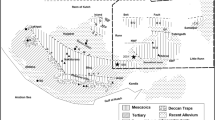Abstract
The method of rectangular harmonic analysis is applied to the geomagnetic field data from central India to isolate long wavelength magnetic anomalies associated with largescale crustal structures. The long-wavelength anomalies have accounted for approximately 20 % of the spatial variability of the residual magnetic field over the International Geomagnetic Reference Field. On the magnetic anomaly map, reflecting the surface expression of longwavelength anomalies, the Tapi-Narmada-Son zone is characterized by a feeble positive anomaly bounded by a strong negative anomaly. The anomaly pattern is believed to be caused by the large-scale undulation in Moho and related variations in the thickness of the lower (basaltic) crust. The other two prominent anomalies, the magnetic low striking northwest and the magnetic high trending east-northeast, appear to be related to the deep structural feature of the Godavari graben and the eastern Rajasthan lineament respectively.
Similar content being viewed by others
References
Agarwal P N and Gaur V K 1972Tectonophysics 15 287
Alldredge L R 1981J. Geophys. Res. 86 3021
Biswas S K and Deshpande S V 1973J. Geol. Soc. India 14 134
Bullard E C 1967Earth Planet. Sci. Lett. 2 293
Ghosh D B 1976Geol. Surv. India. Misc. Publ. 34 119
Hall D H 1974J. Geophys. 40 403
Heron A M 1953Mem. Geol. Surv. India 79 37
Hurwitz L, Fabiano E B and Peddie N W 1974J. Geophys. Res. 79 1716
Kaila K L 1984 Int. Sym. Deep structure of the continental crust: Results from reflection seismology, June, Cornell Univ. New York.
Kaila K L and Krishna V G 1979Geophysics 44 1064
Kaila K L, Krishna V G and Mall D M 1981Tectonophysics 76 99
Kailasam L N 1979Tectonophysics 61 243
Krutikhovskaya Z A and Pashkevich I K 1977Can. J. Earth Sci. 14 2714
Krutikhovskaya Z A and Pashkevich I K 1979J. Geophys. 46 301
Langel R A, Phillips J D and Horner R J 1982aGeophys. Res. Lett. 9 269
Langel R A, Schnetzler C C, Phillips J D and Horner R J 1982bGeophys. Res. Lett. 9 273
Mishra D C 1977Earth Planet. Sci. Lett. 36 301
Pascoe E H 1965A manual of the geology of India and Burma; Manager of Publications, Govt. of India, New Delhi, Vol. I
Qureshi M N 1964 22nd Int. Geol. Congr., New Delhi p. 490
Qureshi M N 1971J. Geophys. Res. 76 545
Qureshi M N 1982Photogrammetria 37 161
Regan R D, Cain J C and Davis W M 1975J. Geophys. Res. 80 794
Roy A K 1971Bull. Geol. Surv. India Ser. B No. 30, Manager of Publications, Delhi
Schnetzler C C and Allenby R J 1983Tectonophysics 92 33
Wasilewski P J and Mayhew M A 1982Geophys. Res. Lett. 9 329
Zietz I, Andreasen G E and Cain J C 1970J. Geophys. Res. 75 4007
Author information
Authors and Affiliations
Rights and permissions
About this article
Cite this article
Arora, B.R., Waghmare, S.Y. Delineation of long-wavelength magnetic anomalies over central India by rectangular harmonic analysis. Proc. Indian Acad. Sci. (Earth Planet Sci.) 93, 353–362 (1984). https://doi.org/10.1007/BF02843253
Received:
Revised:
Issue Date:
DOI: https://doi.org/10.1007/BF02843253




